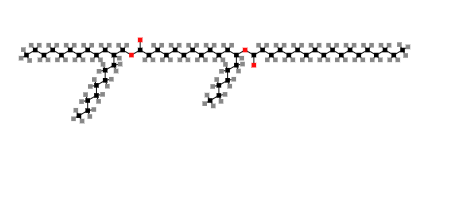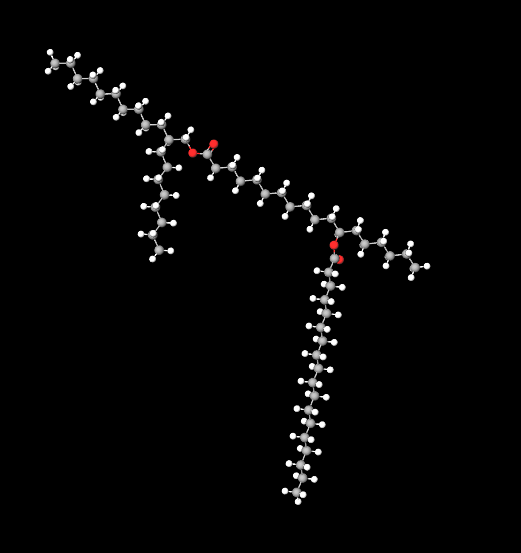Octyldodecyl Stearoyl Stearate is a synthetic ingredient commonly used in the cosmetics industry for its lubricating properties. It is an ester of stearic acid, a naturally occurring fatty acid, and is known for its ability to enhance the texture and performance of skincare and makeup products.
The name describes the structure of the molecule:
Octyldodecyl refers to a fatty alcohol derived from a combination of octyl (eight carbon atoms) and dodecyl (twelve carbon atoms) chains. It suggests a molecule with a long carbon chain, specifically 20 carbon atoms in length, derived from the combination of these two alkyl groups.
Stearoyl comes from "stearic acid", a saturated fatty acid with the formula C₁₈H₃₆O₂. The term "stearoyl" refers to a group derived from stearic acid, indicating the part of the acid minus the hydroxyl group (-OH), replaced in an esterification reaction.
Stearate derives from stearic acid. In this context, "stearate" indicates a salt or an ester of stearic acid. These compounds are commonly used in cosmetics and skin care products as emollients or to provide texture.
Chemical Industrial Synthesis Process
- Leaf Collection. Leaves from the Copernicia Cerifera palm, native to Brazil, are collected during the dry season. The wax forms on the surface of the leaves as protection against evaporation.
- Wax Extraction. The collected leaves are then sun-dried. Once dry, they are beaten or shaken to remove the wax. This process can be done manually or with machinery.
- Purification. The crude wax collected is purified to remove impurities such as leaf residues and debris. Purification may include melting the wax in hot water and subsequent filtration to separate the wax from impurities.
- Refining. After purification, the wax can be further refined through processes such as treatment with activated carbon or bleaching with peroxide to improve its color and purity.
- Forming. The purified and refined wax is then cooled and solidified. It can be formed into various shapes, such as flakes, granules, or blocks, depending on market needs.
- Quality Control. Throughout the production process, quality control checks are performed to ensure that the Copernicia Cerifera wax meets the required standards in terms of purity, color, and physical properties.
What it is for and where
Cosmetics - INCI Functions
Skin conditioning agent - Emollient. Emollients have the characteristic of enhancing the skin barrier through a source of exogenous lipids that adhere to the skin, improving barrier properties by filling gaps in intercorneocyte clusters to improve hydration while protecting against inflammation. In practice, they have the ability to create a barrier that prevents transepidermal water loss. Emollients are described as degreasing or refreshing additives that improve the lipid content of the upper layers of the skin by preventing degreasing and drying of the skin. The problem with emollients is that many have a strong lipophilic character and are identified as occlusive ingredients; they are oily and fatty materials that remain on the skin surface and reduce transepidermal water loss. In cosmetics, emollients and moisturisers are often considered synonymous with humectants and occlusives.
Viscosity control agent. It controls and adapts, Increasing or decreasing, viscosity to the required level for optimal chemical and physical stability of the product and dosage in gels, suspensions, emulsions, solutions.
Commercial Applications
Skincare Products. In skincare, Octyldodecyl Stearoyl Stearate is used to improve the texture and application of products such as creams, lotions, and sunscreens. It helps to make these products more spreadable and enhances their moisturizing capabilities, contributing to a smoother, softer skin feel.
Makeup. This ingredient is particularly valued in makeup formulations, including foundations, eyeshadows, blushes, and lipsticks. It acts as a binder that improves the cohesion of powders and pigments, resulting in a more even and durable application. It also imparts a velvety feel to makeup products, making them more pleasant to apply and wear.
Lip Care Products. In lip balms and lipsticks, Octyldodecyl Stearoyl Stearate contributes to the product's creamy texture, ensuring a smooth application without dragging. It also helps to condition the lips, providing a soft and moisturized feel.
Sun Care Products. It is used in sunscreens for its ability to help formulate more aesthetically pleasing and effective products. By improving the spreadability and feel of sunscreens, it encourages more consistent application and, consequently, better sun protection.
Safety
It is non-irritating and generally considered safe for use in personal care products, making it a popular choice among formulators seeking to improve the texture and sensory experience of their formulations, however, the CIR Expert Panel believes that Octyldodecyl Stearoyl Stearate is safe when formulated to be non-irritating as described in the safety evaluation for use in cosmetic products. Data from the original evaluation indicated that an eyeliner formulation containing 7.5% Octyldodecyl Stearoyl Stearate was moderately irritating to the eye (1).
- Molecular Formula C56H110O4
- Molecular Weight 847.5 g/mol
- CAS 90052-75-8
- UNII 3D47Q6D93C
- EC Number 289-991-0
- DTXSID90869042
- Nikkaji J333.342F
Synonyms
- 2-octyldodecyl 12-octadecanoyloxyoctadecanoate
- 2-Octyldodecyl 12-((1-oxooctadecyl)oxy)octadecanoate
References_____________________________________________________________________
(1) Belsito, M. D., Cohen, D. E., Klaassen, C. D., Rettie, A. E., Ross, D., & Thomas, J. Amended Safety Assessment of Octyldodecyl Stearoyl Stearate as Used in Cosmetics.
Abstract. December 2022-The Expert Panel issued a Tentative Amended Report for public comment with the conclusion that Octyldodecyl Stearoyl Stearate is safe when formulated to be non-irritating as described in the safety assessment. Data from the original assessment indicated an eyeliner formulation containing 7.5% Octyldodecyl Stearoyl Stearate was moderately irritating to the eye. Accordingly, formulators should be aware of this potential and ensure that products containing this ingredient should be formulated to be non-irritating.
![]() Octyldodecyl Stearoyl Stearate
Octyldodecyl Stearoyl Stearate 



